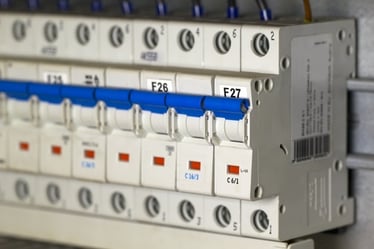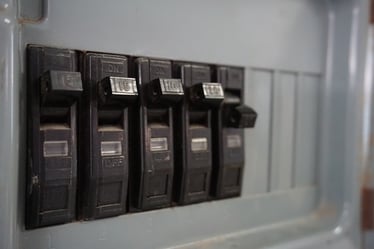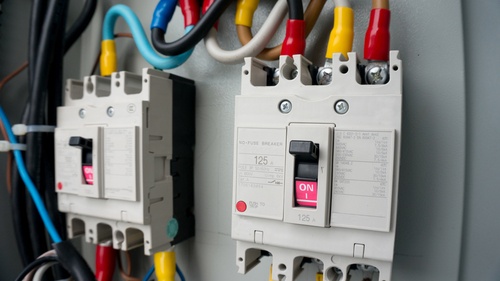Circuit Breakers: Overview and Applications

Circuit breakers are fundamental elements for a safe and code-compliant electrical installation. Conductors and electrical equipment are exposed to damage and malfunction, and there is always a risk that someone may connect a device incorrectly or use it for the wrong application. These conditions can cause a device to draw current above its rated value, and the corresponding circuit breaker trips to disconnect the fault.
Before providing an overview of circuit breakers, it is important to understand the difference between the two main current conditions that cause a circuit breaker to trip.
- An overload current occurs when a device draws current above its rated value, but not by a drastic margin. For example, a motor that is rated at 60 Amperes but drawing 75 Amperes is likely suffering an overload condition.
- A fault current is orders of magnitude higher than the rated current of a circuit, and it occurs when a live conductor touches another at a different voltage (short circuit), or a conductive surface (ground fault). There is a high-magnitude current in both cases, since low-resistance contact is established across a voltage difference. For example, a residential circuit normally carrying 20 Amperes may experience a few thousand Amperes during a fault.
A circuit breaker must trip under both conditions, but the ideal trip response is different for each case:
- The response to an overload current should have a time delay. Some types of equipment draw current above their rated value for short periods of time as part of their normal operation. For example, electric motors draw an inrush current up to 8 times their rated current when they start.
- The response to a fault current should be instantaneous. These currents are not normal under any operating conditions, and they must be cleared immediately when detected.
Given this combination of performance requirements, most circuit breakers actually have two protection mechanisms in a single device. There is a thermal protection mechanism that responds to overload current, and a magnetic protection mechanism that responds to fault currents.
Is Your Electrical Installation Well Protected?
Thermal and Magnetic Protection
The thermal protection mechanism in a circuit breaker is based on an expanding contact: the circuit is interrupted once the contact expands beyond a certain point. The circuit breaker is calibrated so that the contact will not open below rated current, but any current conditions exceeding it will eventually cause a trip. Since current is the heat source that expands the contact, more severe overload conditions cause a faster expansion and a shorter trip time.
The magnetic protection mechanism is based on induction. Current passes through a coil inside the circuit breaker, creating a magnetic field that opens the connection. The field is too weak to trip the breaker under normal operating conditions, but high-magnitude currents cause a strong magnetic field that forces the breaker open.
Main Types of Circuit Breakers
Most circuit breakers found in residential and commercial buildings are either miniature circuit breakers (MCB) or molded-case circuit breakers (MCCB). MCBs are more compact as implied by their name, but MCCBs are available in much higher current ratings and come with additional performance features. MCBs are normally available with a current rating of up to 100 amperes, while MCCBs reach up to 2,500 amperes.
You will probably not find MCCBs in small homes and businesses, but they are common in larger constructions, such as the high rise multi-family and office buildings found throughout New York City.
Miniature Circuit Breakers
Miniature circuit breakers come in two main versions: DIN-rail mountable MCBs can be installed along with other protection and control devices that also use DIN rails, while plug-in MCBs are inserted on load centers with specially designed slots. Keep in mind that DIN-rail MCBs are designed for standard rails, while plug-in MCBs only fit into matching load centers from the same manufacturer.


DIN-rail MCBs (left) and plug-in MCBs (right).
Plug-in MCBs have one to three poles, depending on the number of live conductors in the circuit being protected. DIN-rail MCBs can have up to 4 poles, in order to disconnect the neutral conductor along with the live conductors. Regardless of the type of circuit breaker, it is important to select an adequate rated current and breaking capacity.
- The rated current is determined by the circuit being protected. Any value above this eventually trips the thermal protection mechanism.
- The breaking capacity is the largest fault current that the unit can interrupt without suffering permanent damage. Should a fault exceed this value, there is an ultimate breaking capacity where the breaker can still clear the fault but is permanently damaged. Any fault above the ultimate breaking capacity cannot be cleared by the circuit breaker, and must be handled by a higher capacity protection system connected upstream.
Miniature circuit breakers are also classified into three types based on their response to fault currents: Type B, C and D. The type determines the threshold where the magnetic protection takes over the thermal protection, causing an instantaneous trip. The following table describes the response for each type:
| CIRCUIT BREAKER TYPE | RESPONSE |
|
Type B Type C Type D |
Trips at 3-5 times rated current Trips at 5-10 times rated current Trips at 10-20 timer rated current |
For example, if you have a device that draws 400% rated current during startup, a Type B circuit breaker will trip but a Type C or D will not. Another load drawing 800% rated current during startup would trip both Type B and C breakers, leaving Type D as the only option.
Molded Case Circuit Breakers
MCCBs are bulkier than MCBs and are available with higher current ratings. Many models also feature adjustable trip settings, allowing a very accurate protection response if a specific load needs it.
Some MCCBs also come with a removable trip unit that can be replaced with a smaller capacity unit, to recondition the breaker for a load with reduced current. However, you cannot upgrade to a larger trip unit that exceeds the frame size of the MCCB.

There are modern MCCBs that do not use the conventional thermal-magnetic mechanism, but instead use an electronic circuit that measures current and simulates the trip response. This allows a very precise adjustment of protection settings.
Two subtypes of MCCB are designed specifically for the protection needs of electric motors: Motor protection circuit breakers (MPCB) and motor circuit protectors (MCP). The main difference is that an MPCB includes both thermal and magnetic protection, while an MCP only comes with magnetic protection and needs an external overload relay to offer full protection.
Conclusion
Selecting the right type of circuit breaker is very important to ensure the safe operation of building systems that include electrical components. Undersized breakers trip continuously and disrupt equipment operation, while oversized breakers do not provide reliable protection against overload current. If an overload is not interrupted, the heating effect can damage conductor insulation and eventually cause a ground fault or short circuit.
In New York City your installation must be designed according to the NYC Electrical Code, which also includes the NFPA 70 National Electrical Code. The NYC Energy Conservation Code does not affect breaker selection directly, but the use of more efficient equipment leads to less current consumption and possibly using smaller breakers.

Michael Tobias
Michael Tobias, the Founding Principal of NY Engineers, currently leads a team of 150+ MEP/FP engineers and has led over 4,000 projects in the US
Join 15,000+ Fellow Architects and Contractors
Get expert engineering tips straight to your inbox. Subscribe to the NY Engineers Blog below.

